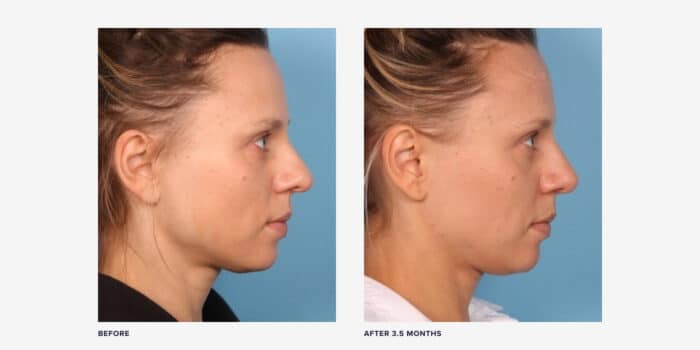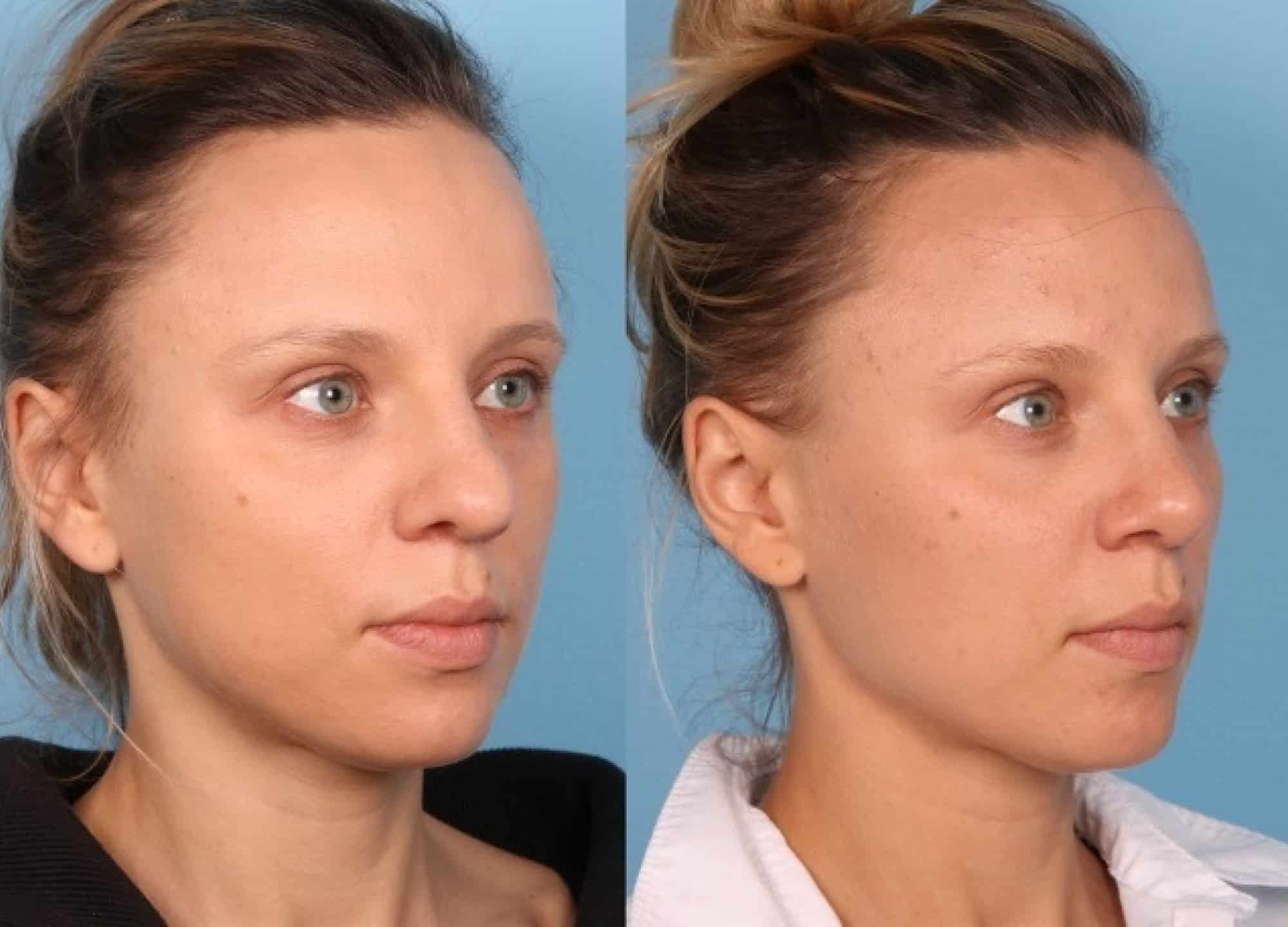I’ve spent more than a decade writing about all kinds of plastic surgery and cosmetic procedures. Not to toot my own horn, but I know a lot about the topic. So when I decided to have a septoplasty (to correct my deviated septum) and rhinoplasty a few months ago, I felt fairly confident that I knew what to expect. Along with using my background professional knowledge, I spoke with people who had had the same surgery, peppering them with questions and asking for insider intel. All that’s to say, I went into the big day feeling confident that I knew exactly what lay ahead in the weeks and months to come. But that wasn’t quite how things played out. While I was definitely well-prepared, there were still some unexpected twists and turns.
Ahead, six things that surprised me most about my septoplasty and rhinoplasty.
1. The pain was nearly nonexistent.
I have a pretty high pain threshold, but I was still prepared for the worst when it came to post-op pain. I dutifully filled the prescription for painkillers that my provider, Dr. Douglas Sidle, a board-certified facial plastic surgeon in Chicago, gave me and stocked up on Tylenol. Turns out, I didn’t need any of it. In the recovery room, the nurses asked me to rank my pain level on a scale of 1 to 10; I put it at a two. Even once the drugs from the surgery wore off, I barely felt any type of pain. I took some Tylenol once I got home from the hospital, and that was it. In my experience, there truly was no actual pain. However, there was a lot of discomfort. To that point…
2. The first week post-op—and the first follow-up appointment—were very tough.
Again, there was no pain per se, but the general discomfort clocked in at a solid 10 out of 10. My nose wasn’t packed, but I did have silicone splints placed inside, to help keep my septum straight. Coupled with plenty of “drippage” (I’ll spare you the gory details), I had a constant feeling of pressure and intense congestion. Thankfully, I had minimal bruising and swelling, which I attribute to both oral and topical arnica and diligent icing for the first 72 hours post-surgery.
Still, wearing the external cast was annoying, particularly when I had to avoid getting it wet while showering or washing my face. I’m a stomach sleeper, so having to sleep on my back was another huge annoyance (even though I had purchased special wedge-shaped pillows specifically for the occasion). There were also things I hadn’t thought about. For example, I was advised to not wear any shirts that pulled over my head so as to not risk banging my nose, so I quickly exhausted my rotation of zip-ups and button-downs.
But it really was just a solid week that was challenging, both physically and mentally. The one week post-op appointment, however, was by far the worst part of the whole process, much more so than the surgery itself. Having the splints removed was one of the most uncomfortable, painful, foreign sensations I’ve ever experienced. It was coupled with some next-level power suctioning of my nostrils that brought me to tears. Luckily, once that was done, the sense of relief was immediate and I could pretty much resume my normal day-to-day activities.
3. I lost my sense of smell and taste.
This was one that I wasn’t expecting and actually hadn’t heard anyone mention. I knew that I would feel somewhat stuffed up, simply because of all the stuff and internal swelling in my nose. But two days post-surgery, my sense of taste and smell were still fine. When they both disappeared overnight on day three, I naturally assumed that I had contracted Covid and spent a solid hour frantically googling “rhinoplasty and loss of taste” while simultaneously panic-texting my doctor’s P.A. Both she and the internet assured me that this was totally normal and would resolve once the splints came out of my nose. It did—hence my immense relief after that post-op appointment—but those few days without any smell or taste were not enjoyable.
4. The results of the septoplasty were immediate.
I distinctly remember waking up in the operating room (admittedly, still very groggy from anesthesia); taking a deep breath through my nose; and saying to my husband, “It worked! I can breathe!” For context, Dr. Sidle had diagnosed me with a mild to moderate septum deviation. It wasn’t unbearable—I had lived with it for many years—but prior to the surgery, I really couldn’t breathe out of my nose. I was an exclusive mouth breather when I slept and felt like I was suffocating anytime I was instructed to breathe through my nose during a yoga class or meditation session. The improvement I’ve experienced since the surgery can’t be understated. It’s kind of like when you think you don’t need glasses, then you put them on and realize what things are actually supposed to look like. I couldn’t believe that I noticed a difference right away. Even in the ensuing days, as the swelling and congestion increased, I could still sense a marked improvement. And it’s only gotten better every day since.

5. But the aesthetic results are definitely not immediate.
I chose to opt for a very minor change when it came to the cosmetic rhinoplasty; Dr. Sidle narrowed the tip of my nose a bit but essentially left everything else unchanged. I knew the results would be super subtle, but I didn’t anticipate quite how long it would take to see them. Both he and everyone I talked to underscored how swollen my nose would be and warned me not to judge the immediate appearance. But when the external cast came off and I first looked in the mirror a week after the surgery, I was blown away—and not in a good way. My nose looked even bigger than it had been pre-surgery. I am not a patient person, so the waiting game has been quite challenging. Dr. Sidle told me that the first 90% of swelling goes down in the first month or so but that it can take another six months to a year for that last 10% to subside. I’m now four months post-op and am finally starting to feel like the aesthetic results are “settling in” the way I want them to.
6. Some days I wish I had made more of a cosmetic change.
My motivation for having this surgery was, first and foremost, to fix my deviated septum so that I could breathe better. I only started contemplating a simultaneous rhinoplasty once I realized how easily it could all be done at the same time. I’ve always been self-conscious about my nose, and I ultimately decided that if I didn’t have this rhinoplasty now, I probably never would. That being said, it wasn’t an easy decision for me. I have a hard time choosing a nail polish color, so making the choice to permanently alter my appearance–as minor as the change was—didn’t come lightly. I struggled with what would happen if I didn’t like the result as well as the general idea that I was changing the face I was born with.
Ultimately, seeing mocked up before and after photos of what the change would look like really helped sway me; I realized that it was possible to achieve a very minor cosmetic tweak that would make me feel much happier and more confident but still look like me. Most days, I wake up and forget I even changed anything about my nose. I do sometimes think maybe I should’ve made a bit more of a drastic change, given how much money I spent and how annoying the whole recovery process was. But at the end of the day, I am happy with how my nose looks now, and I know that this isn’t even the final result.











